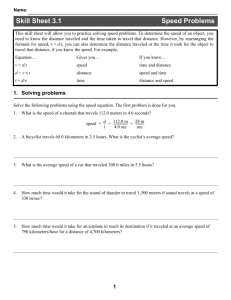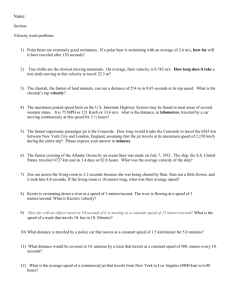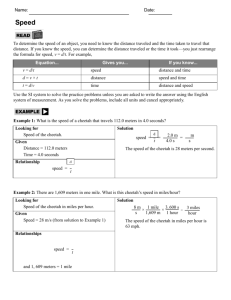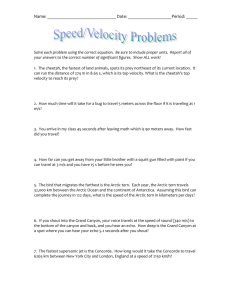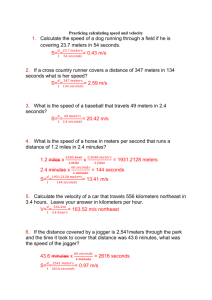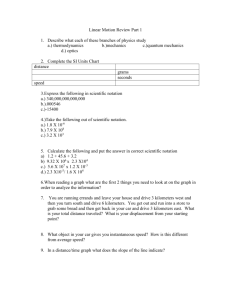PowerPoint Presentation - 12.2 Velocity and Speed
advertisement
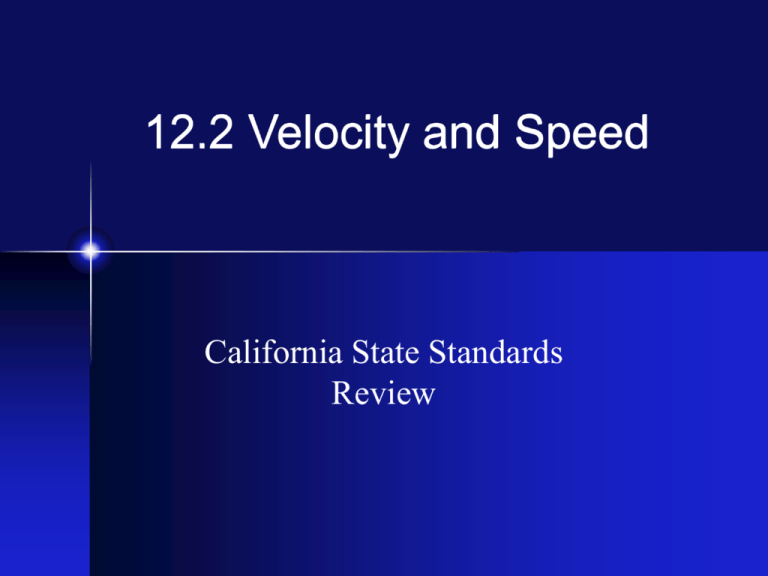
12.2 Velocity and Speed California State Standards Review Speed • To determine the speed of an object, you need to know the distance traveled and the time taken to travel that distance. S= dt • However, by rearranging the formula for speed, v = d/t, (remember V=speed with a direction) • you can also determine the distance traveled or the time it took for the object to travel that distance, if you know the speed. •For example, • Use the SI system to solve the practice problems unless you are asked to write the answer using the English system of measurement. • As you solve the problems, include all units and cancel appropriately. Example 1: What is the speed of a cheetah that travels 112.0 meters in 4.0 seconds? • Looking for: Speed of the cheetah. • Given : Distance = 112.0 meters Time = 4.0 seconds • Relationship Example 2: There are 1,609 meters in one mile. What is this cheetah’s speed in miles/hour? • Looking for: Speed of the cheetah in miles / hour. • Given: Distance = 112.0 meters: • Time = 4.0 seconds • Relationships: • and 1, 609 meters = 1 mile You Try It! • 1. A bicyclist travels 60.0 kilometers in 3.5 hours. What is the cyclist’s average speed? 60km/3.5 hr = 17km/hr • 2. What is the average speed of a car that traveled 300.0 miles in 5.5 hours? 300 miles/5.5 hr = 55 mph • 3. How much time would it take for the sound of thunder to travel 1,500 meters if sound travels at a speed of 330 m/s? T=d/s T= 1500 m/ 330 m/s = 4.5 seconds • 4. How much time would it take for an airplane to reach its destination if it traveled at an average speed of 790 kilometers/hour for a distance of 4,700 kilometers? 5.9hrs • What is the airplane’s speed in miles/ hour? 490mph • 5. How far can a person run in 15 minutes if he or she runs at an average speed of 16 km/hr? (HINT: Remember to convert minutes to hours.) 4.0 km • 6. In problem 5, what is the runner’s distance traveled in miles? 2.5 miles • 7. A snail can move approximately 0.30 meters per minute. How many meters can the snail cover in 15 minutes? 4.5 meters • 8. You know that there are 1,609 meters in a mile. The number of feet in a mile is 5,280. Use these equalities to answer the following problems: • a. How many centimeters equals one inch? • 2.54 cm/inch • b. What is the speed of the snail in problem 7 in inches per minute? • 12 inches/min • 9. Calculate the average speed (in km/h) of a car stuck in traffic that drives 12 kilometers in 2 hours. 6km/hr • 10. How long would it take you to swim across a lake that is 900 meters across if you swim at 1.5 m/s? • a.What is the answer in seconds? 600 seconds • b.What is the answer in minutes? 10 minutes • 11. How far will you travel if you run for 10 minutes at 2 m/s? 1,200 meters • 12. You have trained all year for a marathon. In your first attempt to run a marathon, you decide that you want to complete this 26-mile race in 4.5 hours. • a.What is the length of a marathon in kilometers (1 mile = 1.6 kilometers)? • 42km • b.What would your average speed have to be to complete the race in 4.5 hours? Give your answer in kilometers per hour. • 9.2 km/hr • 13. Suppose you are walking home after school. The distance from school to your home is five kilometers. On foot, you can get home in 25 minutes. However, if you rode a bicycle, you could get home in 10 minutes. • a.What is your average speed while walking? • 0.2km/min • b.What is your average speed while bicycling? • 0.5km/min • c.How much faster you travel on your bicycle? • 0.3 km/min faster • 14. Suppose you ride your bicycle to the library traveling at 0.5 km/min. It takes you 25 minutes to get to the library. How far did you travel? • 12.5km • 15. You ride your bike for a distance of 30 km. You travel at a speed of 0.75 km/ minute. How many minutes does this take? • 40 minutes • 16. A train travels 225 kilometers in 2.5 hours. What is the train’s average speed? 90 km/hr • 17. An airplane travels 3,260 kilometers in 4 hours. What is the airplane’s average speed? • 815 km/hr or 800 km/hr • 18 A person in a kayak paddles down river at an average speed of 10 km/h. After 3.25 hours, how far has she traveled? • 32.5km or 33km • 19. The same person in question 18 paddles upstream at an average speed of 4 km/h. How long would it take her to get back to her starting point? • 8 hours • 20. An airplane travels from St. Louis, Missouri to Portland, Oregon in 4.33 hours. If the distance traveled is 2,742 kilometers, what is the airplane’s average speed? • 633km/hr • 21. The airplane returns to St. Louis by the same route. Because the prevailing winds push the airplane along, the return trip takes only 3.75 hours. What is the average speed for this trip? • 731 km/hr • 22. The airplane refuels in St. Louis and continues on to Boston. It travels at an average speed of 610 km/h. If the trip takes 2.75 hours, what is the flight distance between St. Louis and Boston? • 1,680 km • 23. The speed of light is about 3.00 105 km/s. It takes approximately 1.28 seconds for light reflected from the moon to reach Earth. What is the average distance from Earth to the moon? • 3.84 x 105 km • 24. The average distance from the sun to Pluto is approximately 6.10 109 km. How long does it take light from the sun to reach Pluto? Use the speed of light from the previous question to help you. • 2.03 x 104 sec • 25. Now, make up three speed problems of your own. Give the problems to a friend to solve and check their work. • a.Make up a problem that involves solving for average speed. • b.Make up a problem that involves solving for distance. • c. Make up a problem that involves solving for time. Velocity • Speed and velocity do not have the same meaning to scientists. • Speed is a scalar quantity, which means it can be completely described by its magnitude (or size). • The magnitude is given by a number and a unit. For example, an object’s speed may be measured as 15 meters per second. • Velocity is a vector quantity. In order to measure a vector quantity, you must know the both its magnitude and direction. The velocity of an object is determined by measuring both the speed and direction in which an object is traveling. • If the speed of an object changes, then its velocity also changes. • If the direction in which an object is traveling changes, then its velocity changes. • A change in either speed, direction, or both causes a change in velocity. • You can use v = d/t to solve velocity problems in the same manner that you changed the form of the equation to solve speed problems in Part A. • The boldfaced v is used to represent velocity as a vector quantity. The variables d and t are used for distance and time. • The velocity of an object in motion is equal to the distance it travels per unit of time in a given direction. Example 1: What is the velocity of a car that travels 100.0 meters, northeast in 4.65 seconds? • Looking for • Velocity of the car. • Given • Distance = 100.0 meters • Relationship Example 2: A boat travels with a velocity equal to 14.0 meters per second, east in 5.15 seconds. What distance in meters does the boat travel? • Looking for Distance the boat travels. • Given: Velocity = 14.0 meters per second, east • Time = 5.15 seconds • Relationship Part 2 answers • • • • • • 1. 420km/hr, north 2. 0.30seconds 3. 224 minutes 4. Answers are: a. 1.62m/s, west b.1.62m/s, east Part 2 answers • • • • • 8. 0.22second 9. 1.72miles/min,southwest 10. 116kilometers 11. 3.9km/hr, southeast 12. 564 kilometers

